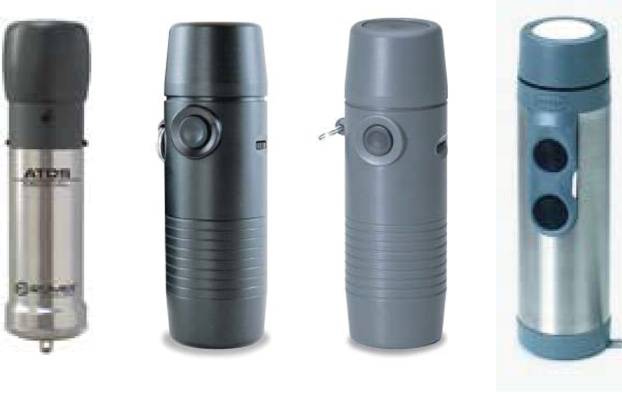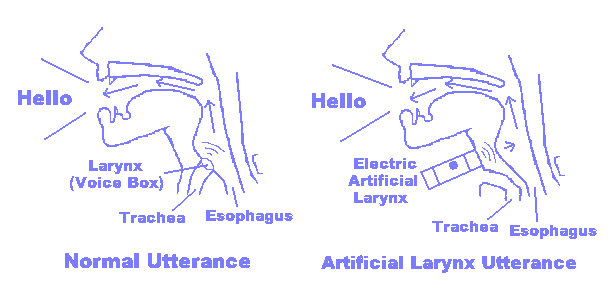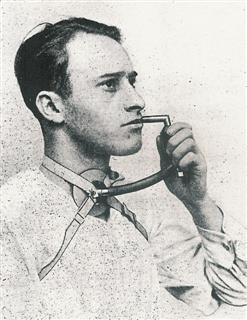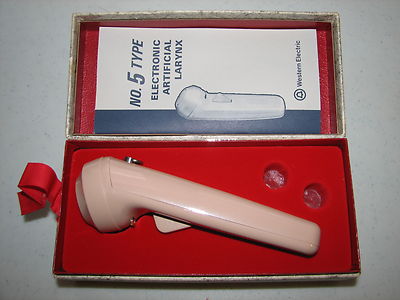Difference between revisions of "Electrolarynx"
(a correction) |
(a correction) |
||
| Line 18: | Line 18: | ||
The sound of patient's voice is produced by the electromagnetic vibration of a device.<ref>UEMI, Norihiro, et al. Design of a new electrolarynx having a pitch control function. In: Robot and Human Communication, 1994. RO-MAN'94 Nagoya, Proceedings. 3rd IEEE International Workshop on. IEEE, 1994. p. 198-203. Available online at: http://ieeexplore.ieee.org/document/365931/?arnumber=365931&tag=1 (Retrieved 18th January, 2017).</ref> The vibrations the device generates are then carried over to the inside of the oral cavity. The user can then use the rest of the vocal tract to shape the sound and speak.<ref name="voice rehabilitation">LIU, Hanjun, NG, Manwa L. Electrolarynx in voice rehabilitation. Auris Nasus Larynx, 2007, 34.3: 327-332.</ref> This allows people who have lost either a part or the entire larynx due to cancer to be able to produce speech and to communicate again. | The sound of patient's voice is produced by the electromagnetic vibration of a device.<ref>UEMI, Norihiro, et al. Design of a new electrolarynx having a pitch control function. In: Robot and Human Communication, 1994. RO-MAN'94 Nagoya, Proceedings. 3rd IEEE International Workshop on. IEEE, 1994. p. 198-203. Available online at: http://ieeexplore.ieee.org/document/365931/?arnumber=365931&tag=1 (Retrieved 18th January, 2017).</ref> The vibrations the device generates are then carried over to the inside of the oral cavity. The user can then use the rest of the vocal tract to shape the sound and speak.<ref name="voice rehabilitation">LIU, Hanjun, NG, Manwa L. Electrolarynx in voice rehabilitation. Auris Nasus Larynx, 2007, 34.3: 327-332.</ref> This allows people who have lost either a part or the entire larynx due to cancer to be able to produce speech and to communicate again. | ||
| − | Electrolarynx is just one of the options for laryngectomees and tracheostomees. After the loss of their voice they could also develop pharyngeal, buccal or oesophageal voice production. However, not every patient is able to develop any of this voice. The voice can be also restored by surgery and the use of silicone prostheses, which is widely discussed in [[Speech prostheses]].<ref>BROWN, Dale H. et al. | + | Electrolarynx is just one of the options for laryngectomees and tracheostomees. After the loss of their voice they could also develop pharyngeal, buccal or oesophageal voice production. However, not every patient is able to develop any of this voice. The voice can be also restored by surgery and the use of silicone prostheses, which is widely discussed in [[Speech prostheses]].<ref>BROWN, Dale H. et al. Postlaryngectomy Voice Rehabilitation: State of the Art at the Millennium, World Journal of Surgery [online]. 2003, 14 May. DOI: 10.1007/s00268-003-7107-4 Available online at: http://link.springer.com/article/10.1007/s00268-003-7107-4 (Retrieved 16th January, 2017).</ref> Patients could also use [[Speech synthesizers|speech synthesizers]]. |
| − | Postlaryngectomy Voice Rehabilitation: State of the Art at the Millennium, World Journal of Surgery [online]. 2003, 14 May. DOI: 10.1007/s00268-003-7107-4 Available online at: http://link.springer.com/article/10.1007/s00268-003-7107-4 (Retrieved 16th January, 2017).</ref> Patients could also use [[Speech synthesizers|speech synthesizers]]. | ||
=== Historical overview === | === Historical overview === | ||
Revision as of 13:53, 28 February 2017
List of Electrolarynges:
Electrolarynges are speech technologies and medical devices. They were developed for laryngectomy patients, who lost their capacity to speak. 'Larynx' in the title of the device means, that it is supposed to replace patient's lost or damaged larynx.
Electrolarynges are electronic devices, mainly powered by battery. They produced a vibration which could user modulate to words by his jaws, tongue and lips.
Contents
Main Characteristics
Electrolarynges are battery-powered devices that replace the sound-vibrating capabilities of the larynx. There are two types of electrolarynges the first neck-type usually resembles a small hand-held tube that the user operates with one hand, while the second intra-oral consists of two parts a pulse generator with a battery and the tone generator.[1] The specific type of intra-oral electrolarynx is UltraVoice, which is intra-dental electrolarynx. It is activated by a remote switch.[2] The former type of devices is put against the tissue of the throat or under the chin.[3] The latter contains a plastic tube which is inserted into patient's mouth,[4] or in case of UltraVoice, is placed in a dental plate and could be used hands-free.[2] The neck-type of electrolarynx is more widely used than the intra-oral type of electrolarynx.[5]
The sound of patient's voice is produced by the electromagnetic vibration of a device.[6] The vibrations the device generates are then carried over to the inside of the oral cavity. The user can then use the rest of the vocal tract to shape the sound and speak.[5] This allows people who have lost either a part or the entire larynx due to cancer to be able to produce speech and to communicate again.
Electrolarynx is just one of the options for laryngectomees and tracheostomees. After the loss of their voice they could also develop pharyngeal, buccal or oesophageal voice production. However, not every patient is able to develop any of this voice. The voice can be also restored by surgery and the use of silicone prostheses, which is widely discussed in Speech prostheses.[7] Patients could also use speech synthesizers.
Historical overview
The current electrolarynges are hand-held electromechanical devices that use a small vibrator to vibrate the inside of the oral cavity. However, pneumatic external larynges were used before miniaturization allowed such devices to be battery-powered and of portable size. The first laryngeal prostheses was described by Czech physiologist Jan Nepomuk Czermak in 1859. This device was not electrical, however, but it was powered by the air. The voice was conducted through vibrating tube in patient's mouth. Based on the ideas of Czermak, Brucke actually invented a speech prostheses, which allowed patients to pronounced single syllables. There were developed a great deal of various artificial larynges in the end of 19th century and the beginning of 20th century. Although majority of the devices was powered by air, certain developers also tested electrical devices.[1]
In the beginning of 20th century, artificial larynges were still unreliable and the quality of sound was not sufficient. These features discouraged many possible patients from purchasing any of these devices. The disadvantages were overcame in 1924 by J. E. Mackenty, who found out than the soft rubber mouth piece could improve the quality of patient's speech. In order to allow shipping of his invention, he cooperate with the Western Electric Company.[1] Therefore, the first available pneumatic artificial larynx was introduced by the Western Electric Company as the Western Electric No° 2 type larynx.[8] It was available on the market from 1930 to 1959.[9] These devices were attached to the tracheostoma of the patient. The device was shaped in such a way that the exhaled air produced a humming noise. It was then carried via a small tube to the inside of the patient's mouth where it served as a base for speech much like the vibrations produced by a modern electrolarynx.[10]
The first battery-powered electrolarynx was introduced by Wright in 1942. After development of his first device, Wright joined Aurex Corporation and later Kett Engineering Corporation, which developed first electrolarynges Aurex Model M 410 resp. Kett Mark I. These devices contained a vibrator connected by the battery with a cord, consequently they were the intra-oral types of electrolarynx. The further models of both companies Aurex Model M 520 and Kett Mark II, however, had battery included in a devices, thus they were the neck-types of electrolarynx.[1] The example of the former type of device could be Cooper-Rand electrolarynx, while the latter type represents Nu-Vois, Romet R, Servox, SolaTone, and TruTone.
Purpose
Electrolarynges is directed towards patients that lost their ability to produce speech. The usage of an electrolarynx, is one of the options which allows them to communicate.
Important Dates
- 1859 - Jan Nepomuk Czermak suggested the first pneumatic laryngeal prosthesis
- 1873 - Billroth conducted the first successful total extirpation of the larynx
- 1924 - Mackenty in cooperation with Western Electric Company developed the first available pneumatic larynx[1]
- 1942 - Wright's first electrolarynx 'Sonovox' was introduced[5]
Enhancement/Therapy/Treatment
The main achievement of electrolarynx is that the device enable to speak again patients which lost their voice. In addition, it is easier to learn how to use electrolarynx than to learn oesophageal voice production. Electrolarynx is also options for patients who cannot learn oesophageal voice production at all. As the fast and easy way how to speak, it is also used by patients who intend to return to their job promptly and voice is essential, in order to manage their job properly.[11] The speech produced by electro larynx is also faster and louder than the oesophageal speech.[5]
In addition, the acquisition of speech by electrolarynx could be also important factor of patient's psychical health. Gardener and Harris report:
Patients have reported that they get a "lift" by using such an aid; they know at once that they will talk again, somehow. Furthermore, they feel more socially acceptable because they can communicate intelligibly and maintain their "speech personality."[11]
Ethical & Health Issues
In comparison with the oesophageal speech, electrolarynges are costly. The price of a device could be covered by health insurance but it is not always the case. In addition, the device contains several components as a battery or plastic tube, which had to be sometimes removed, which further increase the investment.[12]
Several researchers point out that the quality of the voice produced by electolarynx is not as good as other options for people who lost their voice.[12] Liu and Ng argue that the voice produced by Electrolarynx is considered monotonic and robotic, primarily due to limited control of the pitch. However, there are devices as TruTone or Servox, which allows to control the pitch.[5]
The use of a neck-type electrolarynx could be limited by the post-surgery state of the patient. Especially edema, scarred or radiated could cause that the use of this type of electrolarynx does not work properly or hurts patient's tissue. While edema usually disappears in weeks or months after surgery, scarred and radiated tissue could entirely avoid the use of a neck-type electrolarynx.[3]
Although, there is a possibility that the weight of electrolarynges will be reduced in future,[13] the weight of current electrolarynges usually exceeds 100 grams. This could limit patients who are weakened by surgery or other health complications.[4]
The intra-oral types of electrolarynx are more demanding from the hygienic point of view. Moffet and Pindzola point out that more cases of infection were reported in this type of electrolarynx.[14]
Public & Media Impact and Presentation
The users of electrolarynges feature in the newspapers just rarely. Judy Siegel-Itzkovich reports in her article which was published in The Jerusalem Post that one of Holocaust's victims in Israel has to use electrolarynx. His larynx was damaged during medical experiments in a concentration camp by Josef Mengele.[15]
BBC made video's presenting a life of people who use electrolarynx.[16] They point out that the users of electrolarynx could have problems with phone calls[17] and that the voice produced by an electrolarynx is not always sufficiently loud.[18]
Jake Polden from Daily Mail reports Brazilian social experiment, where cigarettes were sold by Joao Candido, the man who lose his voice due to consumption of them. Jake Polden points out that customers were considerably affected by Candido's story.
Joao then drops the biggest bombshell yet and reveals to a curious man what the device is he is holding, allowing him to speak. He tells the man that it is an electronic larynx - something he has had to use since his vocal cords were removed due to larynx cancer. Joao says: 'I had already stopped smoking for 14 years when I had the cancer. But either way it was because of the cigarettes.' The revelation is met with many shocked looks from the customers attempting to buy cigarettes from the man. Later a customer states that the experience scared him slightly, while a woman says that this is the time to stop.[19]
A man who uses electrolarynx was also a part of anti-smoking campaign in USA. He conducted a video in which he sing which his electrolarynx a song with a refrain 'You don't always die on tobacco'.[20]
The characters, who use electrolarynx, appear in several series or films. For instance, 'Charlie' from Mad Max,[21] 'Ned Gerblansky' from South Park,[22] or 'Electrolarynx Guy' from My Name is Earl.[23]
Public Policy
Electrolarynges are medical devices, therefore they has to be listed by FDA and has to comply with European Commission Council directive 93/42/EEC, when their manufacturers intend to distributed them on American or European market.[24][25]
Related Technologies, Projects or Scientific Research
Several proprieties as adapters, tubes, batteries, chargers, cords,[26] and handsfree holders[27] could be purchased.
References
- ↑ 1.0 1.1 1.2 1.3 1.4 KEITH, Robert L., SHANKS, James, Laryngectomee Rehabilitation: Past and Present. In: Speech and Language: Advances in Basic research and Practice. New York: Academic Press, 1983. Available online at: https://books.google.cz/books?id=0C60BQAAQBAJ&pg=PA126&lpg=PA126&dq=Cooper-Rand+electrolarynx&source=bl&ots=or27eudDf2&sig=22heagC08Fpk57qGILvufHxwCyM&hl=cs&sa=X&ved=0ahUKEwi1--bt3r7RAhWGuxQKHbrFCC04ChDoAQgdMAE#v=onepage&q=Cooper-Rand%20electrolarynx&f=false (Retrieved 13th January, 2017).
- ↑ 2.0 2.1 BLOM, Eric D. Current Status of Voice Restoration Following Total Laryngectomy. Oncology [online]. 2000, Jun 1. Available online at: http://www.cancernetwork.com/head-neck-cancer/current-status-voice-restoration-following-total-laryngectomy (Retrieved 19th January, 2017).
- ↑ 3.0 3.1 SHUTE, Brian. There's Nothing Like the Sweet Spot: Placement of the Artificial Larynx. DrShute.com [online]. 1997, Oct. Available online at: http://www.drshute.com/archives/2004/08/theres_nothing.html (Retrieved 16th January, 2017).
- ↑ 4.0 4.1 Advance Health Network. Industry News: Cooper-Rand Electronic Speech Prosthesis. Advance Health Network [online]. Available online at: http://speech-language-pathology-audiology.advanceweb.com/Article/Cooper-Rand-Electronic-Speech-Prosthesis.aspx (Retrieved 13th January, 2017).
- ↑ 5.0 5.1 5.2 5.3 5.4 LIU, Hanjun, NG, Manwa L. Electrolarynx in voice rehabilitation. Auris Nasus Larynx, 2007, 34.3: 327-332.
- ↑ UEMI, Norihiro, et al. Design of a new electrolarynx having a pitch control function. In: Robot and Human Communication, 1994. RO-MAN'94 Nagoya, Proceedings. 3rd IEEE International Workshop on. IEEE, 1994. p. 198-203. Available online at: http://ieeexplore.ieee.org/document/365931/?arnumber=365931&tag=1 (Retrieved 18th January, 2017).
- ↑ BROWN, Dale H. et al. Postlaryngectomy Voice Rehabilitation: State of the Art at the Millennium, World Journal of Surgery [online]. 2003, 14 May. DOI: 10.1007/s00268-003-7107-4 Available online at: http://link.springer.com/article/10.1007/s00268-003-7107-4 (Retrieved 16th January, 2017).
- ↑ RIESZ, R. Description and demonstration of an artificial larynx. Journal of the Acoustical Society of America 1929; 1: 273-9.
- ↑ VAN DER TORN, Marein. A sound-producing voice prosthesis. Ph. D. Thesis. Amsterdam. VU Medical Center: VU Medical Center, 2005.
- ↑ National Cancer Institute. Pneumatic larynx. NCI Dictionary of Cancer Terms [online]. Available online at: http://www.cancer.gov/publications/dictionaries/cancer-terms?CdrID=46223 (Retrieved 16th January, 2016).
- ↑ 11.0 11.1 GARDNER, Warren H., HARRIS, Harold E. Aids and Devices for Laryngectomees. Arch Otolaryngol 73(2) [online]. 1961: 145-152. Doi: 10.1001/archotol.1961.00740020151003 Available online at: http://jamanetwork.com/journals/jamaotolaryngology/article-abstract/1766151 (Retrieved 17th January, 2017).
- ↑ 12.0 12.1 BALASUBRAMANIAN, T. Voice Rehabilitation following Total Laryngectomy. Drbalu.com [online]. 2006. Available online at: http://drtbalu.com/Voice_rehab.html (Retrieved 18th January, 2017).
- ↑ SHUTE, Brian. Current Trends in Electronic Larynges. DrShute.com [online]. 1994, Jul 25. Available online at: http://www.drshute.com/archives/2004/08/current_trends.html (Retrieved 18th January, 2017).
- ↑ MOFFET, Bethann, PINDZOLA, Rebekah H. Acustic Properties of Artifical Larynx Speech. ASHA [online]. 1988. Available online at: http://www.asha.org/uploadedFiles/asha/publications/cicsd/1988AcousticProperties.pdf (Retrieved 16th January, 2017).
- ↑ SIEGEL-ITZKOVICH, Judy. Voice of the people. The Jerusalem Post [online]. 2015, Apr 26. Available online at: http://www.jpost.com/Israel-News/Health/Voice-of-the-people-399185 (Retrieved 17th January, 2017).
- ↑ WebWhispers.org. Electrolarynx: What Do The Various EL Devices Sound Like?. WebWhispers.org [online]. Available online at: http://www.webwhispers.org/library/Electrolarynx.asp (Retrieved 19th January, 2017).
- ↑ CULLING, Bert. Video Nation: Man from Mars. BBC [online]. 2003, Jul. Available online at: http://www.bbc.co.uk/tyne/videonation/stories/man_from_mars.shtml (Retrieved 19th January, 2017).
- ↑ CULLING, Bert. Video Nation: Cat. BBC [online]. 2003, Jul. Available online at: http://www.bbc.co.uk/tyne/videonation/stories/cat.shtml (Retrieved 19th January, 2017).
- ↑ POLDEN, Jake. When smoking does not kill: Smokers receive powerful wake-up call when buying cigarettes from a man with an electrolarynx. Daily Mail [online]. 2015, Sep 2. Available online at: http://www.dailymail.co.uk/news/article-3219431/When-smoking-does-not-kill-Smokers-receive-powerful-wake-call-buying-cigarettes-man-electrolarynx.html#ixzz4W0g49sAC (Retrieved 17th January, 2017).
- ↑ mylexisdhose. Truth singing cowboy. Youtube [online]. 2008, Apr 10. Available online at: https://www.youtube.com/watch?v=eshSlxe9qd0 (Retrieved 17th January, 2017).
- ↑ The Mad Max Wiki. Charlie. The Mad Max Wiki [online]. Available online at: http://madmax.wikia.com/wiki/Charlie (Retrieved 17th January, 2017).
- ↑ South Park Wiki. Ned Gerblansky. South Park Wiki [online]. Available online at: http://southpark.wikia.com/wiki/Ned_Gerblansky (Retrieved 17th January, 2017).
- ↑ My Name Is Earl Wiki. Electrolarynx Guy. My Name Is Earl Wiki [online]. Available online at: http://mynameisearl.wikia.com/wiki/Electrolarynx_Guy (Retrieved 17th January, 2017).
- ↑ U.S. Food and Drug Administration. What does FDA regulate?. U.S. Food and Drug Administration [online]. Available online at: http://www.fda.gov/AboutFDA/Transparency/Basics/ucm194879.htm (Retrieved 17th January, 2017).
- ↑ European Commission. Medical devices. European Commission [online]. Available online at: https://ec.europa.eu/growth/single-market/european-standards/harmonised-standards/medical-devices_en (Retrieved 17th January, 2017).
- ↑ Luminaud Inc. Luminaud: Speech, Voice and Communication Products. Luminaud Inc. [online]. Available online at: http://u.b5z.net/i/u/10204675/f/CF0615pdfbw_c.pdf (Retrieved 17th January, 2017).
- ↑ Griffin Laboratories, Inc. HandsFree Electrolarynx Holder. Griffin Laboratories, Inc. [online]. Available online at: http://www.griffinlab.com/Products/HandsFree-Electrolarynx-Holder.html (Retrieved 17th January, 2017).



